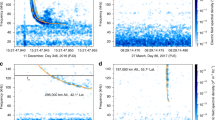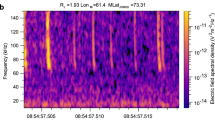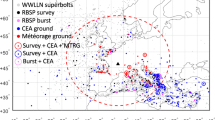Abstract
Within distances of ∼600,000 km from Uranus, the Planetary Radio Astronomy (PRA) experiment aboard the Voyager 2 spacecraft detected impulsive (100–300 ms) bursts of broad-band (≤900 kHz to ∼40 MHz) radio emission. This emission is very different from the uranian magnetospheric radio component, also discovered during the recent Voyager–Uranus encounter1. During the two Saturn encounters, in 1980 and 1981, the PRA experiments detected similar radio emissions2,3, which have been interpreted as radio emissions associated with lightning activity in the atmosphere of the planet4,5. By analogy with the Saturn electrostatic discharges (SED), we have adopted the term uranian electrostatic discharges (UED) for these new radio bursts. We have determined the physical characteristics of UED, and in the context of their interpretation as lightning-associated radio bursts, we derive here ionospheric peak electron densities over the uranian day- and nightside hemispheres.
This is a preview of subscription content, access via your institution
Access options
Subscribe to this journal
Receive 51 print issues and online access
$199.00 per year
only $3.90 per issue
Buy this article
- Purchase on Springer Link
- Instant access to full article PDF
Prices may be subject to local taxes which are calculated during checkout
Similar content being viewed by others
References
Warwick, J. W. et al. Science 233, 102–106 (1986).
Warwick, J. W. et al. Science 212, 239–243 (1981).
Warwick, J. W. et al. Science 215, 582–587 (1982).
Burns, J. A., Showlater, M. R., Cuzzi, J. N. & Durisen, R. H. Icarus 54, 280–295 (1983).
Kaiser, M. L., Connerney, J. E. P. & Desch, M. D. Nature 303, 50–53 (1983).
Warwick, J. W., Pearce, J. B., Peltzer, R. G. & Riddle, A. C. Space Sci. Rev. 21, 309–327 (1977).
Zarka, P. & Pedersen, B. M. J. geophys. Res. 88, 9007–9018 (1983).
Ortega-Molina, A. & Daigne, G. Astr. Astrophys. 130, 301–310 (1984).
Volland, H. in Handbook of Atmospherics, Vol. 1 (ed. Volland, H.) 179–250 (CRC Press, Boca Raton, Florida, 1982).
Evans, D. R., Romig, J. H. & Warwick, J. W. Icarus 54, 267–279 (1983).
Zarka, P. thesis, Univ. Paris VI (1984); in Planetary Radio Emissions (eds Rucker, H. O. & Bauer, S. J.) 237–270 (Verlag der Osterreishischen Akademie der Wissenschaften, 1985).
Tyler, G. L. et al. Science 233, 79–84 (1986).
Davies, K. Ionospheric Radio Propagation (NBS Monogr. (US) 80, Washington DC, 1965).
Ness, N. F. et al. Science 233, 85–89 (1986).
Zarka, P. Astr. Astrophys. 146, L15–L18 (1985).
Rinnert, K. J. geophys. Res. 90, 6225–6237 (1985).
Smith, B. A. et al. Science 233, 43–64 (1986).
Broadfoot, A. L. et al. Science 233, 74–79 (1986).
Author information
Authors and Affiliations
Rights and permissions
About this article
Cite this article
Zarka, P., Pedersen, B. Radio detection of uranian lightning by Voyager 2. Nature 323, 605–608 (1986). https://doi.org/10.1038/323605a0
Received:
Accepted:
Issue Date:
DOI: https://doi.org/10.1038/323605a0
This article is cited by
-
Uranus and Neptune are key to understand planets with hydrogen atmospheres
Experimental Astronomy (2022)
-
Ice Giant Circulation Patterns: Implications for Atmospheric Probes
Space Science Reviews (2020)
-
The Atmospheric Structure of the Ice Giant Planets from In Situ Measurements by Entry Probes
Space Science Reviews (2020)
-
Atmospheric Electricity at the Ice Giants
Space Science Reviews (2020)
-
Atmospheric Dynamics and Vertical Structure of Uranus and Neptune’s Weather Layers
Space Science Reviews (2019)
Comments
By submitting a comment you agree to abide by our Terms and Community Guidelines. If you find something abusive or that does not comply with our terms or guidelines please flag it as inappropriate.



